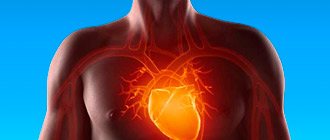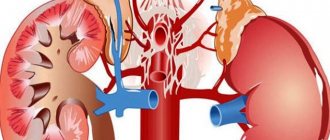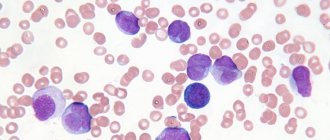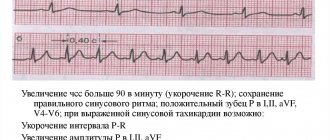Heart obesity develops as a result of the accumulation of lipids in the tissues of the organ. In medicine, the disease is called fatty degeneration of the myocardium. The pathology is accompanied by the replacement of muscle fibers with fat. This leads to disruption of the organ. The likelihood of developing coronary disease and heart failure increases. Myocardial dystrophy does not always appear in overweight people. The disease can be triggered by hereditary disposition or prolonged stress on the body. The treatment is carried out by a cardiologist.
Causes of Fatty Heart
In most cases, obesity of the heart is caused by an unhealthy lifestyle. The main predisposing factor is excess weight. The heart wall consists of three layers. The outer one is connective tissue with a small inclusion of fat. This layer is called the epicardium.
In the middle are muscle fibers. This layer is called the myocardium. The endocardium is located on the inside of the heart. It contains endothelial cells.
If a person leads a healthy lifestyle, a hereditary factor will not be able to provoke the development of myocardial dystrophy.
With myocardial dystrophy, adipose tissue penetrates into the middle layer, contributing to its deformation. As the disease progresses, healthy cells are replaced by fat.
The reasons for the development of pathology include:
- long-term exposure to ionizing radiation;
- hormonal imbalance;
- exceeding daily calorie intake;
- lack of oxygen to heart cells as a result of poor circulation or anemia;
- sedentary lifestyle;
- excessive physical activity;
- exposure to toxic substances;
- alcoholism.
Obesity Treatments
An obese heart can be cured because the changes are reversible. To do this, you need to get rid of the reasons that caused a person’s obesity, control your weight and eat right. Then, after some time, the body will return to its previous rhythm of activity, and all fat will disappear from the heart. You need to understand that losing weight will affect not only visible deposits, but also fat located on the organs. Gradually their work will stabilize, which will cause an improvement in the person’s well-being. You should know that it is not obesity itself that can be dangerous, but the wrong method of getting rid of it. Therefore, the question of how to treat obesity should be under the close attention of a doctor.
Physical activity and special diets should be added to your weight loss program. All this will not only remove unaesthetic traces of weight loss, but will also affect the entire body as a whole, improving and stabilizing its functioning. In advanced cases, doctors can prescribe special medications that reduce the patient's appetite. Surgery can also be used to remove excess fat from both internal organs and visible areas of the human body.
Symptoms of a fatty heart
In the initial stages, there are no symptoms of cardiac obesity. They become apparent only at the stage of replacing more than 20% of healthy cells with fat. It is extremely important to consult a doctor when the first signs of pathology appear. Ignoring the problem can cost a person his life.
Characteristic symptoms of the disease include:
- increased blood pressure;
- swelling of the lower extremities and internal organs;
- increased fatigue;
- heart rhythm disturbance;
- shortness of breath;
- sharp pain in the left side of the chest.
Swelling is considered a specific sign of the disease. When it occurs, thoughts about myocardial dystrophy arise last.
When you press on the skin surface, a dimple is formed on the limb, which does not disappear immediately.
Heart rhythm disorders are divided into the following types:
- extrasystole;
- bradycardia;
- ventricular block.
An increase in pressure is observed in the last stage of the disease. This occurs due to impaired circulatory function in the heart area. Shortness of breath occurs mainly during physical activity. But in advanced cases it becomes chronic.
Symptoms
Symptoms of dangerously fatty heart include:
- The main symptom that is typical for overweight people is shortness of breath. With third-degree obesity, this phenomenon makes itself felt even at rest.
- Heart pain. Due to the degeneration of the tissues of the muscles of the heart organ and their displacement by fat accumulations, a heart rhythm disturbance occurs. All this leads to weakening and decreased performance of the myocardium.
- Interruptions in heart rhythm cause tachycardia, high blood pressure and more dangerous pathologies in the heart muscle.
Diagnosis of fatty heart
If myocardial obesity is suspected, the doctor interviews the patient. The reason for additional examination are complaints of chest pain and shortness of breath. At the initial stage, standard diagnostic procedures do not detect pathology.
In this case, an electrocardiogram is performed. It helps to identify the degree of deviation of the cardiac axis and a decrease in electrical conductivity.
Based on the results of the study, the disease is assigned a certain stage.
In order to analyze the contractility of the myocardial muscles, an ultrasound examination is performed. It also evaluates the size of the organ and the thickness of the heart chambers. To determine the degree of advanced disease, magnetic resonance imaging is prescribed.
To find the cause of obesity, the patient is referred for general clinical blood tests. Additionally, the thyroid gland and adrenal glands are examined.
Clinical picture of obesity. Obesity
Obesity (adipositas) is excessive deposition of adipose tissue in the body. It can be an independent disease (primary obesity) or a syndrome that develops with various diseases of the central nervous system and endocrine glands (secondary obesity).
There are also general and local obesity. Local obesity is characterized by the deposition of fat in the form of lipomas, mainly in the subcutaneous tissue (Dercum's disease, Madelung syndrome).
Obesity is one of the most common diseases. According to WHO, about 30% of the population in economically developed countries has a body weight that exceeds the norm by 20% or more. It is noted that obesity is more often observed in women, especially in age groups over 50 years (50% of cases). There are indications that it is more common among the rural population.
Obesity is a risk factor for diseases such as atherosclerosis, hypertension, and diabetes. Mortality is higher among obese individuals and occurs earlier in life. Obesity increases the risk of death, especially when combined with cardiovascular disease and diabetes. Thus, in the USA it was found that being overweight by 10% increases mortality by an average of 30%. In connection with these data, obesity should be considered as a serious medical and social problem.
Classification. The most common classification is that distinguishes primary or alimentary-exogenous obesity, characterized in the absence of any diseases by exceeding the ideal body weight due to fat accumulation. It is the most common and accounts for more than 75% of all obesity cases. Secondary obesity occurs as a result of endocrine and cerebral diseases.
Etiology and pathogenesis.
1. Primary obesity develops when there is an excess of energy entering the body with food in comparison with the necessary energy expenditure. The leading factor in the development of obesity is a nutritional imbalance caused by excess caloric content of food, mainly due to animal fats and carbohydrates (in 60% of cases of primary obesity); violation of the diet - consuming the bulk of the daily calorie intake in the evening; rare but plentiful meals (40% of all cases of primary obesity). However, the factor of excess food consumption is not necessary for all forms of obesity. There are patients whose daily diet does not include an increase in calorie content, but low physical activity creates excess energy accumulation in the body and contributes to weight gain. With all the variety of etiological factors of obesity, the main one is excess caloric content of food. It has been proven that excess nutrition even in the first months of a child’s life and even in the embryonic period (excessive nutrition of a woman during pregnancy) can have a negative impact on the formation of systems that determine the characteristics of fat metabolism throughout life.
Treatment methods
First of all, drug therapy is aimed at combating obesity. At the same time, factors contributing to the occurrence of the disease are eliminated.
Medical practice shows that existing pockets of fat deposits cannot be completely eliminated. The drugs help stop the growth of pathological tissues and make the patient’s life easier.
Medications
For heart obesity, taking medications that normalize heart rate and vitamins is recommended. In some cases, hormone therapy is required. The treatment regimen is selected purely individually. If edema is present, diuretics are selected.
Furosemide is most often prescribed. It relieves the body of excess moisture, relieving the load on the heart muscles. The drug is available for use by people suffering from kidney diseases.
To reduce pressure on the heart muscles, take Enalapril. It has an inhibitory effect on the enzymatic activity of the hormone synthesis catalyst formed by the kidneys.
As a result of taking Enalapril, the wall of blood vessels relaxes and blood pressure decreases. The drug can provoke negative reactions from the nervous system and skin surface.
If the above medications cannot be used for some reason, drugs that block kidney hormone receptors are prescribed. They act in the same way as ngiotensin-converting enzyme inhibitors.
The main representative of this group of drugs is Valsacor. It reduces swelling, normalizes respiratory function and has a beneficial effect on heart rate.
In order to dilate blood vessels and eliminate spasms that cause pain, Nitroglycerin is prescribed. It is taken directly during a painful attack, since the effect of the drug is short-term.
The effect of drug therapy is observed a month after its start. The patient’s well-being is stabilized: heart rate and blood pressure levels are restored.
To consolidate the effectiveness of drug therapy, the following types of physiotherapeutic procedures are used:
- balneotherapy;
- ozone therapy;
- mud therapy;
- cardiac stimulation;
- exposure to electric current.
The drugs are taken strictly in accordance with the prescribed dosage.
Surgery
Surgery is required if drug therapy does not cope with the disease. The operation is performed if valve replacement is necessary.
After surgery, the patient must be under the supervision of doctors and follow their recommendations.
Exercise stress
Excessive stress on the body negatively affects the heart. Therefore, during treatment it is advisable to completely exclude them.
During the recovery period after drug treatment, sports activities are resumed. The intensity and nature of the loads are discussed with the attending physician. You should return to your normal life gradually.
Traditional treatment
Traditional medicine cannot be used as the main method of treating myocardial dystrophy. It complements drug therapy, increasing its effectiveness.
The following traditional medicines will help improve the functioning of the heart muscle:
- a decoction of goldenrod herbs, viburnum bark, motherwort and valerian;
- black elderberry flowers combined with rosemary and arnica flowers;
- infusion of hop cones, lemon balm, yarrow and valerian root;
- drink based on rosemary, lavender flowers, adonis and beaver.
To prepare a medicinal drink, the ingredients are poured into a small container and poured with a glass of boiling water. It is necessary to cover the infusion with a lid and leave for a couple of hours.
The resulting product is taken chilled, 50 ml per day. The minimum duration of treatment is 1 month.
Forms of obesity
Each specific case of obesity occurs with a predominance of one or another form. The success of treatment depends on how accurately the doctor determines the cause of a person’s obesity.
Scientists identify three forms of obesity
Hyperphagic form
Gluttons suffer from this form of obesity. That is, people do not eat more than what their friends with normal weight eat, but they eat more than their body needs. Naturally, the extra pounds don’t take long to appear.
Gluttons, in turn, are divided into categories:
- Gluttons are gourmets . These “comrades” perceive food as a celebration of life. Therefore, they eat everything that is delicious, sweet, and high in calories.
- Gluttons by circumstance . These are employees of restaurants, canteens, etc., as well as those who constantly have to participate in business lunches. Such people realize that they constantly overeat only when their weight begins to increase.
- Know-Nothing Gluttons . People eat “whatever they have,” and, at some point, high-calorie foods begin to predominate in their food. This is the most mobile category, and it is much easier for those who are included in it to lose weight.
- Hypodynamic form
This form of obesity affects representatives of sedentary professions who do not know how to relax actively, but spend their free hours pleasantly with a book on the sofa or in a chair watching TV. True, representatives of this form of obesity do not eat too much, and their food intake does not depend on a bad mood. Therefore, to lose weight, lazy people do not need cruel diets - a little more walking, dancing and any other physical activity can start the process of losing excess weight. And if such people also limit their consumption of sausages and oils, then getting into shape will not be difficult for them. You just shouldn’t forget that the unloading of the diet should be gradual and at the final stage should not exceed 30%.
Psychogenic form of excess weight
This form of excess weight is the most common. People suffering from this type of obesity first eat up their problems as they arise, and when excess weight is added to all the troubles, it becomes a source of constant stress and the person begins to overeat always and everywhere.
A psychotherapist should participate in the process of losing weight for representatives of the psychogenic form of obesity. It happens that, working only with this specialist, the patient calms down, begins to eat less and loses weight.
There is another form of obesity - genetic predisposition to excess weight .
This type of obesity is the most difficult, not only because obesity is, as it were, “in the blood” of a person, but also because a child, who has been accustomed to overeating since childhood and constantly saw fat people around him, gets used to being fat, and excess weight begins to bother him only when it becomes life-threatening.
It is most difficult for people who are overweight from birth to lose weight - in order to achieve significant results, they need to increase physical activity, constantly monitor their diet and meet with a psychologist.
Diet for fatty heart
The main cause of a fatty heart is poor diet. Therefore, during the treatment of pathology, it is extremely necessary to follow a diet. It is recommended to double the intake of vitamins and minerals involved in metabolic processes.
You should also improve your drinking regime. This will avoid swelling. To get rid of excess fat, it is advisable to limit your daily calorie intake.
The following products must be present in the diet of a person suffering from myocardial dystrophy:
- soups with vegetable or meat broth;
- sources of coenzyme Q10 (cauliflower, carrots, spinach and broccoli);
- cereals;
- dairy products;
- eggs;
- easily digestible meats.
It is necessary to exclude fatty and fried foods from the diet. You also need to give up smoked meats, coffee, fatty meats and spicy foods. The maximum daily salt intake is 3g. Sweets can only be eaten in the first half of the day in strictly limited quantities.
The daily calorie intake is determined individually, depending on the patient’s body weight and height.
Obesity degree. Obesity levels
The degree of obesity is determined by body mass index.
Body mass index (BMI) is calculated using the formula: body weight / height (m) squared.
Let's consider all degrees of obesity in detail.
Pre-obesity. This degree is characterized by the presence of 25-29.9% excess weight compared to the norm. It is considered the initial form, the main symptoms of obesity are absent. It can be easily corrected by following proper nutrition and exercise.
Obesity 1st degree. Characterized by the presence of 30-34.9% deprived weight. Externally, this degree is already more pronounced. It is often regarded not as a disease, but as a cosmetic defect. The first signs of obesity begin to appear - swelling, increased sweating, shortness of breath, etc. This is the stage at which it is necessary to begin taking measures to combat excess weight.
Obesity 2 degrees. Presence of 35-39.9% excess weight. This degree is already expressed even more clearly - significant fat deposits are visible. Symptoms of obesity appear, performance and physical activity decrease. At this level, urgently begin to fight excess weight, because... it can quickly develop into stage 3 obesity.
Obesity 3 degrees. Characterized by the presence of 40% or more excess weight. This degree is very easy to determine by appearance. At this stage, almost all the symptoms of obesity appear: shortness of breath, even in a calm state, swelling of the legs, headaches, disturbances in the functioning of the cardiovascular system, etc. It becomes difficult for a person to take care of himself. You need to urgently contact a specialist and start treatment!
Prevention
Considering the pathogenesis of the disease, it can be prevented by following the principles of prevention. The main rule concerns maintaining a healthy lifestyle. This means quitting smoking and drinking alcohol.
It is also important to keep the body in good shape by playing sports. Visiting the pool and walking in the fresh air are encouraged.
People who are prone to obesity need to maintain daily caloric intake. It is recommended to exclude high-calorie foods from the diet.
Any treatment actions must be agreed with a doctor.
The basis of the diet should be protein foods, vegetables and fruits. It is advisable to limit the consumption of desserts, baked goods and fast food products.
It is equally important to ensure proper rest. The optimal duration of continuous sleep is 7 hours. With its deficiency, metabolic processes slow down, which increases the risk of developing myocardial dystrophy.
Obesity prevention
You need to reconsider your lifestyle and get rid of bad habits. It should be remembered that gaining weight is very easy, but losing it can be difficult. To maintain results, you should adhere to a certain diet.
Do not limit the amount of protein, eat less fast carbohydrates (baked goods, sweets), it is better to replace them with fruits and vegetables. All dietary restrictions should lead to reducing the amount of food consumed and activating metabolism.
Complications of obesity
The need for immediate treatment of obesity is due to the high risk of complications. First of all, they relate to cardiac activity.
If the patient does not take any measures, the following problems arise:
- At stages 3 and 4 of the disease, the structure of the heart may change, which will affect its functioning.
- Myocardial contractility is inhibited over time.
- Against the background of blood stagnation, heart failure develops. It manifests itself in shortness of breath, physical weakness and irregular heartbeat.
- In advanced cases, the likelihood of developing coronary artery disease increases.
- There is a deterioration in respiratory function. There is a lack of air and constant shortness of breath. Lack of oxygen affects human performance.
- The risk of sudden death due to cardiac arrest increases.
How does obesity affect the heart?
If you want to know how obesity affects the heart and still hope that there is nothing pathologically wrong with this condition, then you are sadly mistaken. Obesity is always bad.
- Patients with fatty heart disease often have hypertension, which further increases the risk of strokes or heart attacks.
- In a massive body, the volume of circulating blood increases significantly, which the heart has difficulty pumping. As a result, myocardial hypertrophy begins - its walls thicken, and the volumes of the chambers increase, although this still cannot compensate for the load on the heart. If obesity continues to progress, heart failure will begin and blood stagnation will occur in both circulation circles.
- If a person has grade III-IV obesity, then serious changes in the structure of the heart begin. The adipose tissue located in the epicardium grows significantly.
- Sometimes fatty degeneration of the heart is observed - the appearance of islands of adipose tissue among the striated muscles of the myocardium. This phenomenon significantly weakens the heart muscle, reducing its ability to contract. However, it should be recognized that fatty degeneration is much less likely to be a consequence of general human obesity; it is much more often caused by severe forms of inflammatory diseases.
- There is an impact of obesity on the heart and breathing, which can lead to serious problems.
- Excess fat tissue present in the abdominal cavity also interferes with the functioning of the heart. The amplitude of vibrations of the diaphragm decreases as the chest is compressed. Therefore, the body also experiences a secondary indirect pathological effect.
How to lose weight at home
Important! You can use folk remedies against obesity only after consulting a nutritionist or your doctor!
To lose weight, try to follow these recommendations:
- drink 1 glass of warm water every morning on an empty stomach;
- replace black tea with green;
- drink freshly squeezed fruit and vegetable juices;
- eat fresh fruits, vegetables and herbs;
- do not eat fresh bread - replace it with yesterday’s bread, or better yet, crackers;
- dishes, when cooking, boil, stew or bake (try to exclude fried);
- Have a fasting day once a week;
- play sports.










